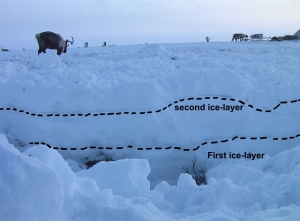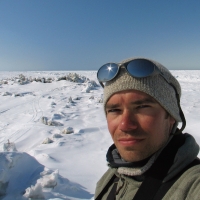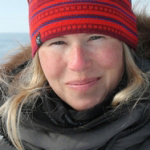Project Abstract
 Rain on Snow (ROS) and extreme precipitation events have significant impacts on Arctic wildlife, livestock, and the communities that depend on these resources for subsistence. The icy crusts that form after ROS events and deep snow can interfere with travel and searching for food. ROS events have been linked to massive die-offs of reindeer and caribou. Polar bear and ringed seal populations are also affected--rains early in the breeding season destroy dens built under the snow and increase cub/pup mortality. The purpose of this study is to better understand the frequency and cause of ROS and extreme precipitation events across the Arctic, how their frequency and severity are changing as the Arctic warms, and their social-ecological impacts. With a primary focus on hunting and reindeer herding livelihoods, this study involves close collaborations with Indigenous hunters and herders.
Rain on Snow (ROS) and extreme precipitation events have significant impacts on Arctic wildlife, livestock, and the communities that depend on these resources for subsistence. The icy crusts that form after ROS events and deep snow can interfere with travel and searching for food. ROS events have been linked to massive die-offs of reindeer and caribou. Polar bear and ringed seal populations are also affected--rains early in the breeding season destroy dens built under the snow and increase cub/pup mortality. The purpose of this study is to better understand the frequency and cause of ROS and extreme precipitation events across the Arctic, how their frequency and severity are changing as the Arctic warms, and their social-ecological impacts. With a primary focus on hunting and reindeer herding livelihoods, this study involves close collaborations with Indigenous hunters and herders.
ROS and extreme precipitation events will be detected using various types of satellite data, weather data from atmospheric re-analyses, and surface observations. Indigenous hunters and herders will be engaged through extensive local observing, interviews, group discussions, and participatory workshops to validate the detection algorithms, and to assess effects of ROS and extreme precipitation events on wildlife and community activities. Similarly, the project will partner with reindeer herders to better understand implications for modern tundra reindeer nomadism and mortality episodes significant enough to have entered the oral record. Expert systems models will be developed to assess how ROS and extreme precipitation events impact wildlife, migratory reindeer herding, hunting, and other community activities in terms of event timing, geographic scale, snow/land cover, and existing community practices. A Data and Knowledge Hub, serving as the project website and a resource on the state of knowledge regarding Arctic ROS and extreme precipitation events and their impacts, will become the project's extension to the US Arctic Observing Network. The project also closely connects with the NSF ELOKA (Exchange for Local Observations and Knowledge of the Arctic) project, and long-time/on-going research collaboration with Inuit hunters, communities across Northern Alaska, and applied community-based ecological research in Lapland and Russia.
Logistics Summary
This project will use a systematic, pan-Arctic evaluation of historical Rain on Snow (ROS) frequency and intensity, extreme precipitation events, and their impacts on human-environment systems, with a focus on hunting and in particular, reindeer herding livelihoods, spanning the period 1979 to the present. This includes working in partnership with Indigenous knowledge holders in remote Arctic regions. The Co-PI will meet with Alaskan partners at annual project workshops in Alaska in years 2 and 4 (2021 and 2023) during the Alaska Tribal Conference on Environmental Management (ATCEM). At the same time, he will meet with many other Alaskan Indigenous leaders, Elders, and community members. Also, in years 2 and 4, a trip is planned for the Co-PI to travel to Clyde River, Nunavut to conduct fieldwork with Inuit hunters. Also, one field team member will travel to Rovaneimi once per year to meet with Bruce Forbes at the University of Lapland, for which a subaward has been awarded. The University of Lapland team will be working with local reindeer herders on this project and will facilitate direct contact to reindeer herders on a regular basis and provide access to herders’ perspectives on recent ROS events as well as archival records. Lastly, a special meeting (“Day of Reindeer”) will bring together three Indigenous project partners from Alaska and three from Nunavut to travel to Yamal to meet with the Boulder-based research team and University of Lapland team in Y2. The planned trip to Yamal will be unique and will be in addition to ongoing participant observation field work in Yamal, Alaska, Nunavut, and Finland. The team will be regularly conducting field research in their respective field locations, then bringing everyone together to Yamal. A Subaward to the Local Environmental Observer (LEO) Network at Alaska Pacific University is included in this project in partnership with the Alaska Native Tribal Health Consortium (ANTHC), to implement the Local Environmental Observers (LEO) Network.
Season Field Site
2021 Alaska - Anchorage
2021 Canada - Clyde River, Baffin Island
2021 Finland - Rovaniemi
2021 Russia - Yamal Peninsula
2023 Alaska - Anchorage
2023 Canada - Clyde River, Baffin Island
2023 Finland - Rovaniemi
Keywords
Arctic, snow, rain, reindeer, hunting, Lapland, Alaska, Canada
Project Location
Website
Project WebsiteDates
-Location
Anchorage, AK; Baffin Island, Canada; Rovaniemi, Finland; Yamal Peninsula, RussiaMembers
Principal Investigator

Co-Principal Investigator

Co-Principal Investigator

Co-Principal Investigator

